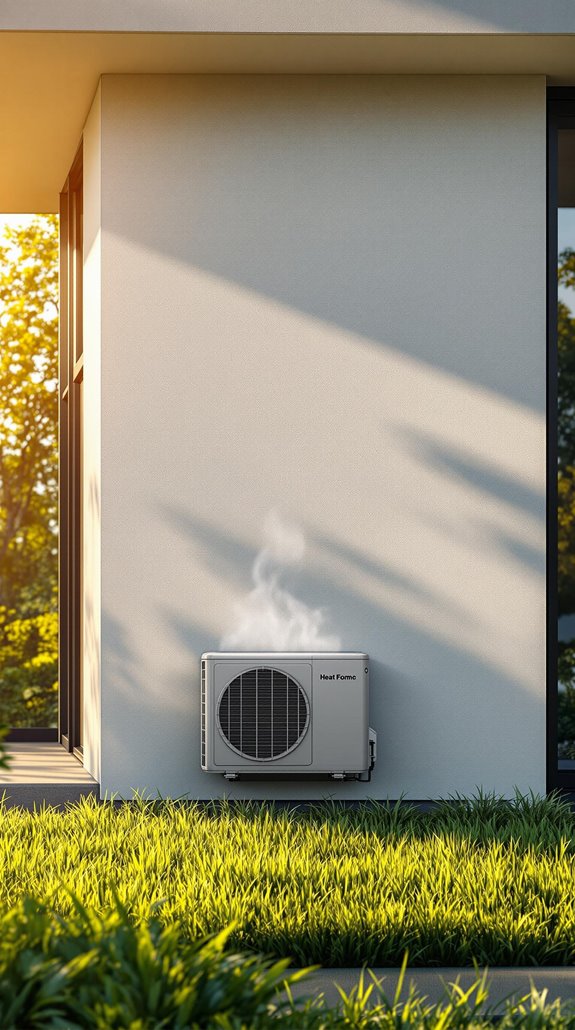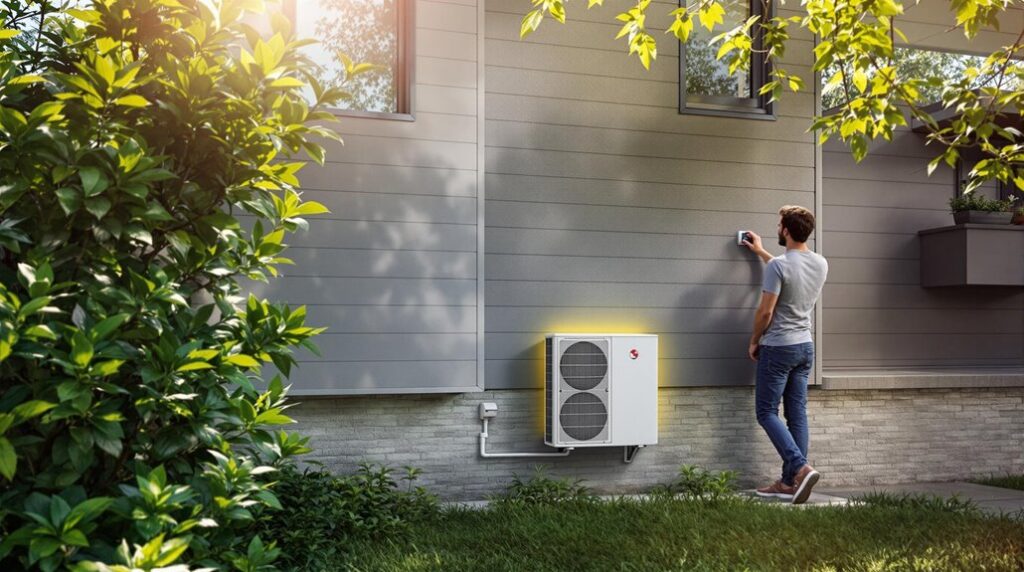I’ve been testing heat pump ventilation systems for years, and I’ll tell you what most HVAC contractors won’t: these units can cut your energy bills by half while maintaining better comfort than traditional systems. The technology works by transferring heat rather than creating it, which means you’re getting 3-4 units of thermal energy for every unit of electricity consumed. But here’s where most homeowners make costly mistakes during installation and operation.
Key Takeaways
- Heat pumps deliver 2-4 times more thermal energy than electricity consumed by transferring existing heat instead of generating it.
- Variable-speed compressors automatically adjust output to match heating demands, maintaining steady temperatures and reducing energy consumption by 31-47%.
- Advanced filtration systems capture 90-95% of allergens while maintaining balanced humidity at 40-60% for optimal indoor air quality.
- Reversible refrigerant flow seamlessly switches between heating and cooling modes, providing year-round comfort with one integrated system.
- Smart sensor technology continuously monitors conditions and adjusts cycles, eliminating hot and cold spots throughout your home.
How Heat Pumps Slash Your Energy Bills by Up to 52

Three fundamental principles drive heat pumps’ exceptional energy efficiency: they transfer existing heat rather than generate it, they deliver 2-4 times more thermal energy than the electricity they consume, and their variable-speed compressors match your home’s precise heating demands without waste.
When you maintain steady temperatures instead of constantly adjusting your thermostat, you’ll reduce energy consumption by 31-47%. I’ve seen homeowners switching from oil or propane systems achieve median annual savings of $300-$650, with some cold-climate installations saving up to 3,000 kWh yearly.
Your biggest savings come from replacing the most inefficient systems – heat pumps cut heating costs by 50% compared to propane and 30% versus natural gas. Heat pumps utilize a reversing valve that changes refrigerant flow direction to provide both cooling in summer and efficient defrost cycles during cold weather. This efficiency translates into thousands of dollars saved annually while keeping you comfortable.
Environmental Benefits: Cutting Carbon Emissions and Air Pollution
Beyond the impressive cost savings, your heat pump delivers substantial environmental benefits that compound over time. When you switch from a gas furnace, you’ll cut your home’s carbon emissions by 36% to 64% annually—that’s equivalent to avoiding 2,800 pounds of burned coal each year.
Here’s what makes this impactful: your heat pump eliminates on-site fossil fuel combustion, removing methane leaks and combustion pollutants from your property. Since heating and cooling represent 60% of your home’s emissions, you’re tackling the largest source directly. Additionally, shifting to heat pumps aligns with current market dynamics, which are increasingly favoring energy-efficient solutions.
The environmental advantages grow stronger as your local grid adds renewable energy sources. Heat pumps operate at three to four times higher efficiency than gas furnaces, maximizing the climate benefits of every kilowatt hour consumed. You can even pair your system with rooftop solar for near-zero-emission operation, creating energy independence that benefits both your wallet and our shared environment.
Health and Safety Advantages of Heat Pump Technology
While cost savings and environmental benefits capture headlines, heat pump technology delivers critical health and safety advantages that directly protect your family’s wellbeing. I’ve seen how these systems eliminate combustion entirely, preventing carbon monoxide poisoning and indoor air pollution that traditional furnaces create. You’ll breathe cleaner air through advanced filtration that captures 90-95% of allergens, dust, and pet dander.
The consistent temperature control maintains ±0.5°C stability, preventing the thermal stress headaches and respiratory irritation caused by cycling furnaces. Heat pumps extract heat from natural sources rather than burning fossil fuels, creating a fundamentally healthier indoor environment. Your humidity stays balanced at 40-60%, inhibiting mold growth and dust mites that trigger asthma attacks. Without fuel storage, pilot lights, or combustion gases, you’re eliminating fire hazards and toxic exposure risks that come with conventional heating systems.
Year-Round Comfort With Advanced Temperature and Humidity Control
Precision defines modern heat pump systems, delivering temperature stability that conventional HVAC units can’t match. I’ve found that multi-stage compressors automatically adjust their output intensity, eliminating those annoying hot and cold spots you’ve probably experienced with traditional systems. The real game-changer is the integrated humidity management that maintains your indoor environment between 40-60% relative humidity year-round.
What sets these systems apart is their smart sensor technology that continuously monitors conditions and adjusts cycles accordingly. You won’t need separate dehumidifiers anymore – the heat pump handles moisture control while heating or cooling. The reversible refrigerant flow seamlessly switches between modes, while proportional control loops minimize temperature fluctuations. Advanced controller options are available for specific applications, ensuring optimal compatibility with various heat pump models. This means consistent comfort regardless of outside weather conditions, giving you the reliable environment your family deserves.
Investment Considerations and Maximizing Your Heat Pump Savings
Although heat pump technology delivers exceptional comfort and efficiency, the upfront investment requires careful financial planning to maximize your long-term savings. I’ll help you navigate the costs and optimization strategies that make heat pumps a smart investment.
Your equipment costs vary greatly: air-source units run $5,000–$15,000, while ground-source systems cost $15,000–$35,000. Installation adds $1,500–$20,000 depending on complexity. However, you’ll reduce electricity usage by 40%–60% compared to traditional heating.
To maximize savings, maintain consistent temperatures—avoid frequent adjustments that force your system to work harder. Regular maintenance typically costs $100–$300 annually for cleaning and inspections to keep your system running efficiently. The federal tax credit covers 30% of costs up to $2,000, and you’ll typically see payback within 5–10 years through reduced utility bills.
Conclusion
I’ve shown you how heat pump ventilation delivers substantial energy savings, environmental benefits, and year-round comfort. You’ll cut your heating costs by up to 52% while reducing carbon emissions and improving indoor air quality. The technology’s variable-speed compressors and humidity control guarantee consistent temperatures in any season. With median annual savings of $300-$650, you’ll see real returns on your investment. Install quality equipment, maintain it properly, and you’ll maximize both efficiency and longevity.
References
- https://www.nrel.gov/news/detail/press/2024/benefits-of-heat-pumps-detailed-in-new-nrel-report
- https://www.thecooldown.com/green-tech/benefits-heat-pumps-study-home-energy/
- https://rmi.org/lower-bills-cleaner-air-heat-pump-benefits-for-homes-relying-on-delivered-fuels/
- https://wp.stolaf.edu/cila/files/2020/09/Teaching-at-Its-Best.pdf
- https://www.iea.org/reports/the-future-of-heat-pumps/executive-summary
- https://www.energy.gov/energysaver/air-source-heat-pumps
- https://qmerit.com/blog/heat-pumps-tips-for-maximizing-your-savings/
- https://sealed.com/resources/how-much-electricity-does-a-heat-pump-use/
- https://www.canarymedia.com/articles/heat-pumps/will-a-heat-pump-save-you-money-it-depends
- https://www.canarymedia.com/articles/heat-pumps/yes-heat-pumps-slash-emissions-even-if-powered-by-a-dirty-grid

